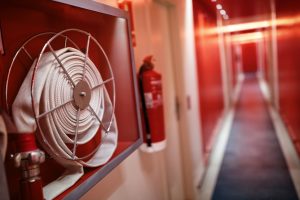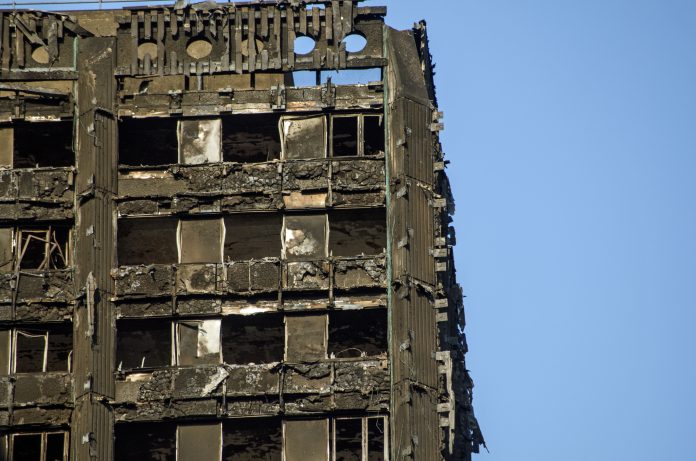The Fire Safety Regulations 2022 were introduced to implement recommendations made after the Grenfell Tower fire, and they impose significant responsibilities on those in charge of these types of buildings
If you are the responsible person for a high-rise block of flats or a multi-occupied residential building above 11 metres in height, under the Fire Safety Regulations 2022, you must provide information to Fire and Rescue Services and take additional safety measures to ensure that your building is adequately protected from the risk of fire.
This includes:
- Complying with design and construction requirements
- Installing and maintaining appropriate fire safety equipment
- Developing a fire risk management plan
- Providing training for staff and tenants
- Conducting regular inspections
- and facing potential consequences if non-compliance occurs.
Overview of the Fire Safety Regulations 2022
The new Fire Safety Regulations 2022 build upon the existing Fire Safety Order.
Key requirements include providing up-to-date electronic building floor plans and external wall system information to local Fire and Rescue Services, installing secure information boxes on site, checking lifts and other key firefighting equipment monthly, and providing wayfinding signage visible in low light or smoky conditions.
Additionally, responsible persons must provide relevant fire safety instructions to residents and ensure that they understand the importance of fire doors.
The implementation timeline for these regulations began on January 23rd, 2023.
The regulations apply only in England but cover all premises, including workplaces and common parts of multi-occupied residential buildings.
Compliance challenges may arise due to the requirement for responsible persons of high-rise buildings to share information electronically with Fire and Rescue Services.
However, this ensures that the Fire Service has the necessary information to respond effectively to potentially complex fires.
Communication with residents is a critical aspect of compliance with these regulations. Responsible persons must provide them with fire safety instructions tailored to their building’s evacuation strategy.
Regular checks on firefighting equipment such as lifts and door systems are essential factors that should be communicated transparently with residents so that they can report any faults detected promptly.
Design and construction requirements
Design and construction requirements require responsible persons to use fire-resistant materials for external wall systems and undertake regular fire safety audits to identify any potential risks.
Additionally, responsible persons are required to install fire suppression systems such as sprinklers and smoke alarm systems.
Building codes also play an important role in ensuring fire safety compliance.
Responsible persons must follow building codes and guidelines when designing and constructing new buildings or making changes to existing ones.

These codes outline minimum requirements for things like emergency exits, stairwells, elevators, and other critical components that could impact the ability of residents to evacuate safely during a fire.
Fire safety training is another crucial aspect of complying with the Fire Safety Regulations 2022. Responsible persons must provide training for building occupants on how to respond in case of a fire emergency.
This includes instructions on evacuation procedures, safe use of firefighting equipment, and awareness about the importance of keeping fire doors closed at all times.
Installation and maintenance of fire safety equipment
Regular maintenance of fire safety equipment is crucial in ensuring that they are functioning properly in the event of a fire emergency.
Fire extinguishers should be installed throughout the building, with different types for different classes of fires. Check them regularly to make sure they are fully charged and have not been tampered with.
Smoke detectors should be placed in every room and hallway and tested monthly to ensure they are working properly.
Emergency lighting should also be installed throughout the building to provide visibility during power outages or smoke-filled environments.
In addition to having fire safety equipment installed, evacuation plans should also be developed and practised regularly with residents. Ensure that all exit routes are clear of obstacles at all times and that everyone knows where to go in case of an emergency.
Fire risk management plans
A comprehensive fire risk management plan should be regularly reviewed, updated and communicated to all relevant parties.
Here are some key elements to consider when developing your fire risk management plan:
- Assessment process: Conducting regular risk assessments is important in identifying potential hazards, assessing the level of risk associated with them, and determining appropriate control measures.
- Evacuation procedures: Having clear evacuation procedures in place can help ensure that occupants are safely evacuated in case of a fire emergency. These procedures should be communicated clearly to all occupants, including any visitors or contractors.
- Emergency response: Having an effective emergency response plan can help minimize damage and injuries in case of a fire. This includes having designated individuals responsible for coordinating emergency response efforts, ensuring that firefighting equipment is available and easily accessible, and providing training to staff on how to respond effectively during an emergency.
- Fire safety audits: Regularly conducting fire safety audits can help identify potential weaknesses or areas for improvement in your fire risk management plan. This includes reviewing evacuation routes, checking that firefighting equipment is properly maintained, inspecting electrical systems and appliances for potential hazards, and ensuring that building materials meet relevant safety standards.
- Communication: Effective communication is critical during a fire emergency. Make sure you have multiple ways to communicate with occupants during an emergency (e.g., public address systems), designate individuals responsible for communicating with external agencies (e.g., Fire Service), and provide training to all staff on how to communicate effectively during an emergency.
Responsibilities of business owners and property managers
Under the Fire Safety Regulations 2022, business owners and property managers are required to take proactive measures to prevent fires by conducting regular fire risk assessments, implementing fire safety technology and evacuation procedures, and providing tenant education.
One of the key responsibilities of business owners and property managers is to conduct regular fire safety audits on their premises.
These audits should identify potential fire hazards, assess the risks associated with them, and provide recommendations for remedial action where necessary.
The audit report should also be shared with relevant stakeholders like tenants, employees, contractors or other visitors.
Fire safety training for staff and tenants
Business owners and property managers can promote a safe environment by providing regular training and education to staff and tenants on fire safety procedures, creating a culture of awareness and preparedness.
This can help in ensuring that everyone is well-equipped to handle any fire emergencies that may arise.
Tenant education should focus on the importance of following evacuation procedures, which include promptly leaving the building when an alarm sounds, closing doors behind them as they leave, using stairwells instead of elevators, and going to designated assembly areas.
Staff training should be conducted regularly to ensure that employees are familiar with their roles during a fire emergency. They should be trained on how to use firefighting equipment such as extinguishers correctly.
Fire drills should also be carried out frequently so that staff members become familiar with the sound of alarms and know what actions they need to take immediately after hearing one.
It’s important for business owners and property managers to keep records of their staff training sessions and fire drills so they can identify areas where improvement is needed.
Inspections and enforcement of fire safety measures
The Fire Safety Regulations 2022 require responsible persons to undertake monthly checks on the operation of lifts intended for use by firefighters, and evacuation lifts in their building, as well as checking the functionality of other key pieces of firefighting equipment.

They must report any defective lifts or equipment to their local Fire and Rescue Service as soon as possible after detection if the fault cannot be fixed within 24 hours, and record the outcome of checks and make them available to residents.
Fire safety inspections are carried out by local Fire and Rescue Services to ensure that multi-occupied residential buildings are complying with the regulations.
Consequences of non-compliance
Failing to comply with fire safety regulations can have serious consequences, including fines, legal action, and potentially putting the lives of residents at risk.
If you fail to provide your local Fire and Rescue Service with up-to-date electronic building floor plans or information about your external wall systems, you may be fined or face legal action.
This could also put residents at risk if the Fire Service does not have crucial information needed for an effective response.
Non-compliance with requirements for monthly checks on lifts and other key firefighting equipment could also lead to fines and legal action.
Additionally, failure to undertake annual checks of flat entrance doors or quarterly checks of all fire doors in common parts could result in evacuation delays during a fire.

















